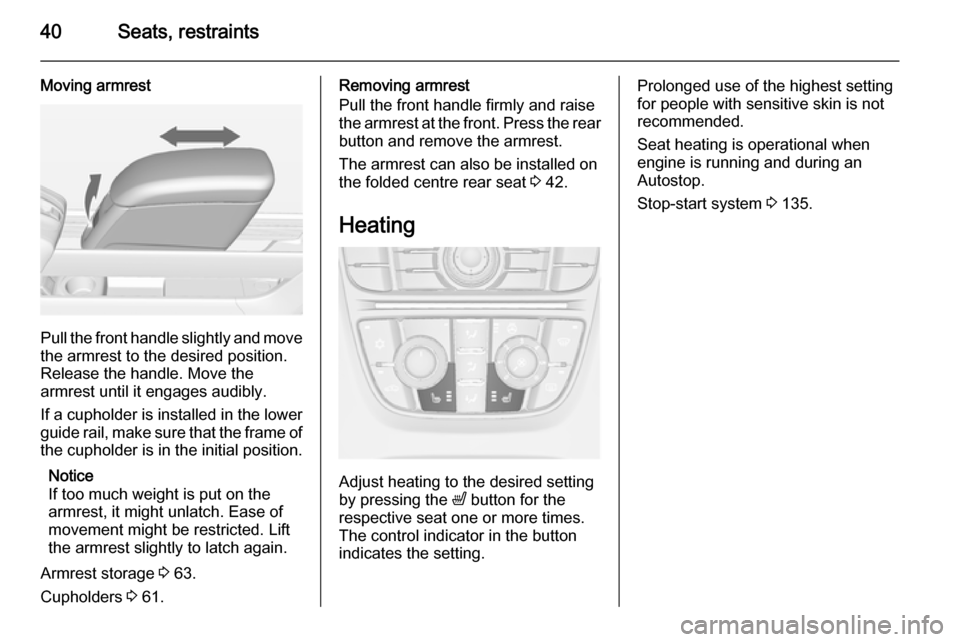weight VAUXHALL MERIVA 2014.5 Owner's Manual
[x] Cancel search | Manufacturer: VAUXHALL, Model Year: 2014.5, Model line: MERIVA, Model: VAUXHALL MERIVA 2014.5Pages: 237, PDF Size: 7.59 MB
Page 42 of 237

40Seats, restraints
Moving armrest
Pull the front handle slightly and move
the armrest to the desired position.
Release the handle. Move the
armrest until it engages audibly.
If a cupholder is installed in the lower
guide rail, make sure that the frame of the cupholder is in the initial position.
Notice
If too much weight is put on the armrest, it might unlatch. Ease of
movement might be restricted. Lift
the armrest slightly to latch again.
Armrest storage 3 63.
Cupholders 3 61.
Removing armrest
Pull the front handle firmly and raise the armrest at the front. Press the rear button and remove the armrest.
The armrest can also be installed on
the folded centre rear seat 3 42.
Heating
Adjust heating to the desired setting
by pressing the ß button for the
respective seat one or more times.
The control indicator in the button
indicates the setting.
Prolonged use of the highest setting
for people with sensitive skin is not
recommended.
Seat heating is operational when engine is running and during an
Autostop.
Stop-start system 3 135.
Page 59 of 237

Seats, restraints57Child restraint installation locationsPermissible options for fitting a child restraint system
Weight and age class
On front passenger seat
On rear outboard seatsOn rear centre seat
activated airbagdeactivated airbagGroup 0: up to 10 kg
or approx. 10 monthsXU 1U 2U3Group 0+: up to 13 kg
or approx. 2 yearsXU 1U2U3Group I: 9 to 18 kg
or approx. 8 months to 4 yearsXU 1U2U 3Group II: 15 to 25 kg
or approx. 3 to 7 yearsXXU 2U3Group III: 22 to 36 kg
or approx. 6 to 12 yearsXXU 2U31=If the child restraint system is being secured using a three-point seat belt, move seat height adjustment to uppermost
position and ensure that vehicle seat belt runs forwards from the upper anchorage point. Adjust seat backrest
inclination as far as necessary to a vertical position to ensure that the belt is tight on the buckle side.2=Only if outboard seats are in position 1 or 2, 3 41.3=Only if outboard seats are flush with the centre seat (position 2, 3 41).U=Universal suitability in conjunction with three-point seat belt.X=No child restraint system permitted in this weight and age class.
Page 60 of 237

58Seats, restraints
Permissible options for fitting an ISOFIX child restraint systemWeight classSize classFixtureOn front passenger
seatOn rear outboard seatsOn rear centre seatGroup 0: up to 10 kg
or approx. 10 monthsEISO/R1XIL 1XGroup 0+: up to 13 kg
or approx. 2 yearsEISO/R1XIL 1XDISO/R2XIL1XCISO/R3XIL1XGroup I: 9 to 18 kg
or approx. 8 months to 4 yearsDISO/R2XIL 1XCISO/R3XIL1XBISO/F2XIL1
, IUF 1, 2XB1ISO/F2XXI1
L, IUF 1, 2XAISO/F3XIL1
, IUF 1, 2XGroup II: 15 to 25 kg
or approx. 3 to 7 yearsXIL 1XGroup III: 22 to 36 kg
or approx. 6 to 12 yearsXIL 1X
Page 61 of 237

Seats, restraints59
IL=Suitable for particular ISOFIX restraint systems of the 'specific-vehicle', 'restricted' or 'semi-universal' categories.The ISOFIX restraint system must be approved for the specific vehicle type.IUF=Suitable for ISOFIX forward-facing child restraint systems of universal category approved for use in this weight class.X=No ISOFIX child restraint system approved in this weight class.1=Only if outboard seats are in position 1 or 2, 3 41.2=Only for Vauxhall child restraint system: If the seat is secured as recommended 3 54, the outboard seats must be
in position 2 3 41.
ISOFIX size class and seat device
A – ISO/F3=Forward-facing child restraint system for children of maximum size in the weight class 9 to 18 kg.B – ISO/F2=Forward-facing child restraint system for smaller children in the weight class 9 to 18 kg.B1 – ISO/F2X=Forward-facing child restraint system for smaller children in the weight class 9 to 18 kg.C – ISO/R3=Rear-facing child restraint system for children of maximum size in the weight class up to 18 kg.D – ISO/R2=Rear-facing child restraint system for smaller children in the weight class up to 18 kg.E – ISO/R1=Rear-facing child restraint system for young children in the weight class up to 13 kg.
Page 82 of 237

80Storage
■ Use the hook at the left sidewall ofthe load compartment for hanging
up carrier bags. Pull out the hook.
Maximum load: 3 kg.
■ Secure loose objects in the load compartment to prevent them from
sliding.
■ When transporting objects in the load compartment, the backrests of
the rear seats must not be angled
forward.
■ Do not allow the load to protrude above the upper edge of the
backrests.
■ Do not place any objects on the load compartment cover or the
instrument panel, and do not cover
the sensor on top of the instrument panel.
■ The load must not obstruct the operation of the pedals, parking
brake and gear selector, or hinder
the freedom of movement of the
driver. Do not place any unsecured objects in the interior.
■ Do not drive with an open load compartment.9 Warning
Always make sure that the load in
the vehicle is securely stowed.
Otherwise objects can be thrown
around inside the vehicle and
cause personal injury or damage
to the load or vehicle.
■ The payload is the difference between the permitted gross
vehicle weight (see identification
plate 3 211) and the EC kerb
weight.
To calculate the payload, enter the
data for your vehicle in the Weights
table at the front of this manual.
The EC kerb weight includes
weights for the driver (68 kg),
luggage (7 kg) and all fluids (tank
90 % full).
Optional equipment and
accessories increase the kerb
weight.
■ Driving with a roof load increases the sensitivity of the vehicle to
cross-winds and has a detrimental
effect on vehicle handling due to
the vehicle's higher centre of
gravity. Distribute the load evenly
and secure it properly with retaining
straps. Adjust the tyre pressure and vehicle speed according to the load
conditions. Check and retighten the straps frequently.
Do not drive faster than 75 mph.
The permissible roof load is 60 kg. The roof load is the combined
weight of the roof rack and the load.
Page 161 of 237

Driving and operating159
Fuel consumption data and CO2
emission data are determined
according to regulation R (EC) No.
715/2007 (in the version respectively
applicable), taking into consideration
the vehicle weight in running order, as specified by the regulation.
The figures are provided only for the
purpose of comparison between
different vehicle variants and must not be taken as a guarantee for the
actual fuel consumption of a
particular vehicle. Additional
equipment may result in slightly
higher results than the stated
consumption and CO 2 figures.
Furthermore, fuel consumption is
dependent on personal driving style
as well as road and traffic conditions.Trailer hitch
General information
Only use towing equipment that has
been approved for your vehicle.
Entrust retrofitting of towing
equipment to a workshop. It may be
necessary to make changes that
affect the cooling system, heat
shields or other equipment.
Fitting of towing equipment could
cover the opening of the towing eye.
If this is the case use the coupling ball
bar for towing. Always keep the
coupling ball bar in the vehicle.
Driving characteristics and
towing tips Before attaching a trailer, lubricate
the coupling ball. However, do not do so if a stabiliser, which acts on the
coupling ball, is being used to reduce
snaking movements.
For trailers with low driving stability
and caravan trailers with a permitted
gross vehicle weight of more than1100 kg the use of a stabiliser is
strongly recommended when driving
above 50 mph.
If the trailer starts snaking, drive more slowly, do not attempt to correct the
steering and brake sharply if
necessary.
When driving downhill, drive in the
same gear as if driving uphill and
drive at a similar speed.
Adjust tyre pressure to the value
specified for full load 3 224.
Trailer towing Trailer loads9 Warning
Vehicles with engine A13DTE:
Use of towing equipment is
permissible for attaching
compatible bicycle carriers only.
Do not use towing equipment for
trailer towing.
Page 162 of 237

160Driving and operating
The permissible trailer loads are
vehicle and engine-dependent
maximum values which must not be
exceeded. The actual trailer load is the difference between the actual
gross weight of the trailer and the
actual coupling socket load with the
trailer coupled.
The permissible trailer loads are
specified in the vehicle documents. In general, they are valid for gradients
up to max. 12 %.
The permitted trailer load applies up to the specified incline and up to an
altitude of 1000 metres above sea
level. Since engine power decreases
as altitude increases due to the air becoming thinner, therefore reducing
climbing ability, the permissible gross
train weight also decreases by 10 %
for every 1000 metres of additional
altitude. The gross train weight does
not have to be reduced when driving
on roads with slight inclines (less than
8 %, e.g. motorways).The permissible gross train weight
must not be exceeded. This weight is specified on the identification plate
3 211.
Vertical coupling load
The vertical coupling load is the load
exerted by the trailer on the coupling
ball. It can be varied by changing the
weight distribution when loading the
trailer.
The maximum permissible vertical
coupling load (75 kg) is specified on
the towing equipment identification
plate and in the vehicle documents
Always aim for the maximum load,
especially in the case of heavy
trailers. The vertical coupling load
should never fall below 25 kg.Rear axle load
When the trailer is coupled and the
towing vehicle fully loaded, the
permissible rear axle load (see
identification plate or vehicle
documents) may be exceeded by
80 kg (vehicles with LPG system:
110 kg), the gross vehicle weight
rating may be exceeded by 70 kg
(vehicles with LPG system: 95 kg). If
the permissible rear axle load is
exceeded, a maximum speed of
60 mph applies.
Towing equipmentCaution
When operating without a trailer,
remove the coupling ball bar.
Page 213 of 237

Technical data211Identification plate
The identification plate is located on
the rear right-hand door frame.
Information on identification label:1=Manufacturer2=Type approval number3=Vehicle Identification Number4=Permissible gross vehicle
weight rating in kg5=Permissible gross train weight
in kg6=Maximum permissible front axle load in kg7=Maximum permissible rear axle
load in kg8=Vehicle-specific or country-
specific data
The combined total of front and rear
axle loads must not exceed the
permissible gross vehicle weight. For
example, if the front axle is bearing its
maximum permissible load, the rear
axle can only bear a load that is equal
to the gross vehicle weight minus the front axle load.
The technical data is determined in
accordance with European
Community standards. We reserve
the right to make modifications.
Specifications in the vehicle
documents always have priority over
those given in this manual.
Engine identification
The technical data tables show the
engine identifier code. Engine data
3 215.
To identify the respective engine,
refer to the engine power in the EEC
Certificate of Conformity provided
with your vehicle or other national
registration documents.
Page 220 of 237
![VAUXHALL MERIVA 2014.5 Owners Manual 218Technical dataPerformanceEngineB14XERB14NELB14NETMaximum speed4)
[mph]Manual transmission5)5)5)Automatic transmission–1155)4) The maximum speed indicated is achievable at kerb weight (without dr VAUXHALL MERIVA 2014.5 Owners Manual 218Technical dataPerformanceEngineB14XERB14NELB14NETMaximum speed4)
[mph]Manual transmission5)5)5)Automatic transmission–1155)4) The maximum speed indicated is achievable at kerb weight (without dr](/img/38/19512/w960_19512-219.png)
218Technical dataPerformanceEngineB14XERB14NELB14NETMaximum speed4)
[mph]Manual transmission5)5)5)Automatic transmission–1155)4) The maximum speed indicated is achievable at kerb weight (without driver) plus 200 kg payload. Optional equipment could reduce the specified maximum
speed of the vehicle.
5) Value was not available at time of printing.EngineB16DTCB16DTLB16DTNB16DTHMaximum speed 4)
[mph]Manual transmission5)5)5)5)Automatic transmission––––4) The maximum speed indicated is achievable at kerb weight (without driver) plus 200 kg payload. Optional equipment could reduce the specified maximum
speed of the vehicle.
5) Value was not available at time of printing.
Page 221 of 237
![VAUXHALL MERIVA 2014.5 Owners Manual Technical data219
EngineA13DTCA13DTEA17DTIMaximum speed4)
[mph]Manual transmission99104–Automatic transmission––1114) The maximum speed indicated is achievable at kerb weight (without driver) p VAUXHALL MERIVA 2014.5 Owners Manual Technical data219
EngineA13DTCA13DTEA17DTIMaximum speed4)
[mph]Manual transmission99104–Automatic transmission––1114) The maximum speed indicated is achievable at kerb weight (without driver) p](/img/38/19512/w960_19512-220.png)
Technical data219
EngineA13DTCA13DTEA17DTIMaximum speed4)
[mph]Manual transmission99104–Automatic transmission––1114) The maximum speed indicated is achievable at kerb weight (without driver) plus 200 kg payload. Optional equipment could reduce the specified maximum
speed of the vehicle.